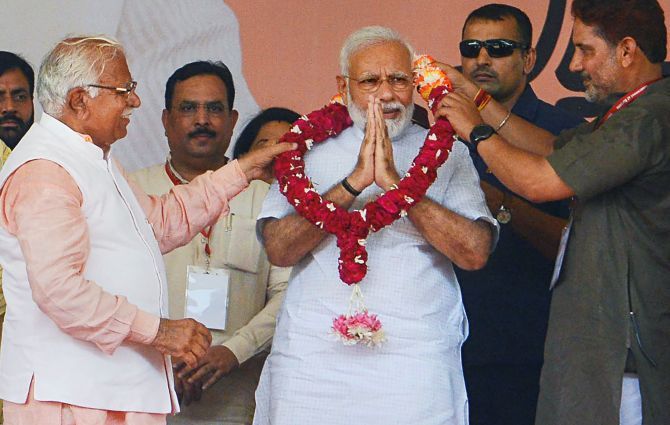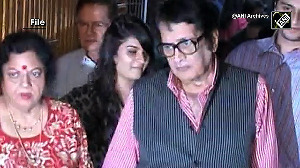Ankur Bhardwaj looks at what works in favour of the government and what works against it in Haryana.

On October 21, voters in Haryana and Maharashtra will exercise their franchise to elect their new governments. The counting will take place on October 24, 2019.
In the general elections held earlier in the year to elect the Union government, both states had overwhelmingly stood with the Bharatiya Janata Party (in Haryana) or with the BJP-led alliance (in Maharashtra).
While in Maharashtra, the National Democratic Alliance (BJP+Shiv Sena) won 41 seats out of 48, in Haryana, the BJP swept all the ten Lok Sabha seats.
In both the states, the BJP had formed governments in 2014 after Narendra Modi became prime minister.
In Haryana, first time MLA, Manohar Lal Khattar was installed as chief minister.
A former Rashtriya Swayamsevak Sangh pracharak, Khattar has weathered a turbulent phase as CM and now faces a test to return to power.
Let's take a look at the political chessboard in Haryana and what works in favour of the government and what works against it.
The Modi factor
The BJP formed the government in the state for the first time in 2014, riding on the coat-tails of the 2014 Modi wave.
The politics in the state is closely tied to the politics of the Centre.
In the past 30 years, the state has returned to power the same party or alliance that won the Lok Sabha polls.
In 2014, incumbent Bhupinder Singh Hooda had been in power for a decade (like the United Progressive Alliance in Delhi) and was battling double anti-incumbency.
As the Narendra Modi wave spread across Hindi-speaking India, it swept through the fields in Haryana as well.
Lok Sabha elections result of 2019 tells us the Modi wave has only consolidated since then, instead of waning.
The BJP improved its tally in the state from seven in 2014 to all 10 in 2019.
With the prime minister's popularity intact, the Khattar government already has a leg-up.
Low index of opposition unity
The two main political formations in the state on the opposition side are the Indian National Congress and the Indian National Lok Dal.
The party of former Haryana CMs, O P Chautala and Devi Lal, the INLD suffered a setback ahead of the 2019 Lok Sabha polls when the party split and Dushyant Chautala formed the Jannayak Janata Party.
With the patriarch of the family, O P Chautala convicted and jailed (out on parole), the party has leadership trouble and is in a weak position to take on the BJP, even in areas where it has traditionally been strong.
The Congress party, on the other hand, has been facing the same issue for the last few years, that of factionalism.
The party moved to make changes in state leadership after Sonia Gandhi took over as interim president of the party from Rahul Gandhi.
The changes may have come too late, however, as news reports indicate. There seems to be a lack of synergy between the outgoing state chief and the leadership entrusted with running the campaign in the state now.
As the opposition remains in a bit of disarray, it has made the BJP's job in the state easier.
The governance question
The Manohar Lal Khattar government and the CM himself have been attacked by the Opposition in the state for lack of experience in governance and inability to face administrative challenges.
This criticism was justified by two incidents that happened in the last five years in the state.
The first was the Jat reservation agitation in 2016 that ended in huge rioting. The state government failed to first assuage the agitators, and then to manage the law and order situation as things turned violent.
Places like Rohtak and Jhajjar were cut off from the rest of the state as mobs went across towns setting markets on fire.
The government set up the Prakash Singh Committee, the first part of whose report pointed to lapses made by the government.
An embarrassed government asked the committee to not go ahead with the second part.
The same situation was repeated in 2017 when rioting broke out in Panchkula and other parts, after Gurmeet Ram Rahim Singh, the head of the Dera Sacha Sauda, was convicted by the courts.
The government was blamed for its lackadaisical approach as it failed to act despite being warned about the possibility of violence.
More than 30 people are reported to have lost their lives.
Moreover, there have been no other major governance initiatives that the government pushed in these five years.
It made a push for improving the state's child sex ratio (834 in the 2011 census). The figures improved dramatically, but were found to be discrepant in the audit.
Caste
As per the 2011 census, Haryana’s population is 87.46 per cent Hindu. 21 of the 22 districts have a Hindu majority. Caste arithmetic plays an important role in the state’s politics.
Jats are around 25 per cent of the state’s population and have historically played a dominant role in the state’s politics as well. However, the state’s politics rhetorically revolves around '36 biradari' or all the communities.
Support that cuts across caste groups is a recipe for success in the states.
While the 2016 Jat agitation riots may have been a governance failure for the Khattar government, they have been a political success for the BJP. In the absence of any religious polarisation in the state, there have been signs of caste polarisation.
Political experts from the state talk about the BJP's '35 biradari' strategy to help consolidate different caste blocks. The results of the Lok Sabha polls seem to indicate that this strategy is paying the party rich dividends in the state.
Among the opposition parties, the INLD and the JJP are seen to be more closely aligned with Jat interests while the Congress party has historically been the umbrella party in the state, an impression that the BJP has tried to change post the 2016 riots.
While these remain the major factors that will play a role in the upcoming assembly polls in the state, there could be other factors that may play the role of spoilers for one or the other party.
Unemployment
The state's economy has gone from being dominated by agriculture in 1966 to being dominated by industry and services now.
According to a CMIE report (May-August 2019), the state had the highest unemployment rate in the country in August, 2019 at 28.68 per cent.
With a major crisis in the auto sector and huge job losses in the auto belt in Gurgaon-Manesar, the state’s politics might find the issue resonating more in these elections.
Candidate selection
With the BJP in the pole position, it also increases the pressure on the party from ticket seekers. The party has dropped seven sitting MLAs (including 2 ministers) from its list of candidates for the polls.
While the Congress faces factionalism, the BJP might face similar trouble from any rebel candidates on some seats.
With its slogan ‘Ab ki Baar, 75 Paar’ (This time, more than 75), the BJP has an ambitious target of winning 75 out of the state’s 90 seats.
In a low-key election, the BJP seems to be flying with a tailwind in the state.












 © 2025
© 2025